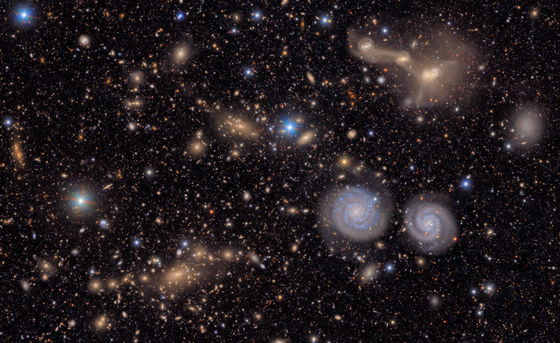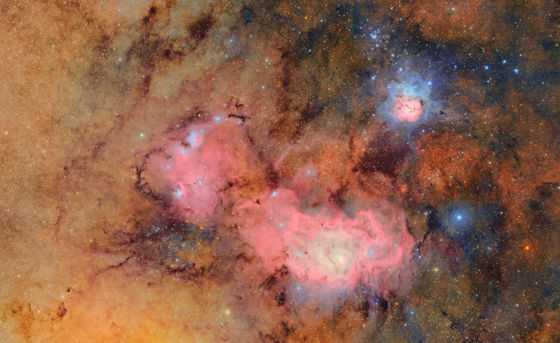Rubin Observatory, equipped with the world's largest camera, releases first images

by RubinObs/NOIRLab/SLAC/NSF/DOE/AURA
The Cosmic Treasure Chest | Rubin Observatory
https://rubinobservatory.org/news/rubin-first-look/cosmic-treasure-chest
Introducing...your sneak peek at the cosmos captured by @NSF – @doescience Vera C. Rubin Observatory!
— NSF-DOE Rubin Observatory (@VRubinObs) June 23, 2025
Can you guess what regions of sky they are?
This is just a peek...join us at 11am US EDT for your full First Look at how Rubin will #CaptureTheCosmos ! https://t.co/1a74X2edp8 pic.twitter.com/DE3tx2RQI4
Vera C. Rubin Observatory releases 'sneak peek' of first images taken with world's largest camera | Live Science
https://www.livescience.com/space/astronomy/rubin-observatory-releases-sneak-peek-of-first-images-taken-with-worlds-largest-camera
The Rubin Observatory is an observatory with a huge visible light telescope with an aperture of 8.4 meters, built at an altitude of 2,650 meters on Mount Pachón in Chile. The Rubin Observatory is expected to revolutionize astronomy, and what is so great about it is summarized in the following article.
What's so great about the Rubin Observatory, which is expected to revolutionize astronomy?

by Wikimedia Commons
The Rubin Observatory has released the images it took for the first time.
The video below shows images of the southern region of the Virgo Cluster , located about 55 million light years away from Earth, taken by the Rubin Observatory. The Virgo Cluster is the closest galaxy cluster to the Milky Way Galaxy, where Earth resides. The image shows an astonishing variety of celestial objects, including bright blue and red stars, blue spiral galaxies, and distant red galaxies. The image is said to be composed of more than 1,100 images taken by the Rubin Observatory. The image shows about 10 million galaxies, but the total number of galaxies that the Rubin Observatory will observe over the next 10 years is expected to be about 20 billion.
The Cosmic Treasure Chest - VIDEO - EN - YouTube
Using the Rubin Observatory, astronomers will be able to address questions such as 'How did the Milky Way form?' and 'What is 95% of the invisible universe made up of?'
Each image taken by the Rubin Observatory covers 10 square degrees (about 45 full moons). The Rubin Observatory takes pictures of the same location at different times and with different color filters, and by combining these images, it is said that it is possible to reveal extremely fine details that cannot be captured in a single image. The image released this time is a composite of 1,185 images, and was taken over a period of only 'seven nights.'
Rubin Observatory plans to photograph the same area multiple times over the next decade, capturing brief but significant events like supernova explosions and flares as stars are swallowed by black holes. Rubin Observatory's software will automatically compare each new image to templates it creates from previous images, identifying up to 10 million changes each day and providing insights into short-lived cosmic events and moving objects.
Astronomers will also be working to solve some of the universe's greatest mysteries: dark matter and dark energy. By mapping the shape and distribution of galaxies over time, scientists will be able to infer the underlying structure of dark matter and observe how the expansion of the universe is affected by dark energy.
Below is a close-up of the Virgo Cluster taken by the Rubin Observatory, which includes two spiral galaxies, three merging galaxies, nearby and distant galaxy groups, and stars within the Milky Way galaxy.

by RubinObs/NOIRLab/SLAC/NSF/DOE/AURA
Rubin also captured

by RubinObs/NOIRLab/SLAC/NSF/DOE/AURA
The Trifid Nebula, seen in the upper right of the image, is a cloud of gas and dust located about 5,000 light-years away in the direction of the constellation Sagittarius. It combines several features in one place, including a pinkish diffuse nebula, a bluish reflection nebula, and dark dust lanes. New stars are being born within the Trifid Nebula, emitting strong winds and radiation that cut through the surrounding gas.
In addition, the Lagoon Nebula is visible below the Trifid Nebula, which is located about 4,000 light years away. The Lagoon Nebula is visible with binoculars and small telescopes, and at its center is a group of young, massive stars. The Lagoon Nebula offers scientists a unique opportunity to study the early stages of star formation: how giant clouds collapse, how star clusters form, and how newborn stars begin to change their surroundings.
Related Posts:






